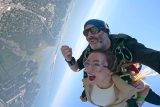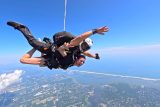Can You Go Skydiving And Scuba On The Same Day?
Skydiving
Posted by: Long Island Skydiving Center
7 years ago
Listen up, adventurers! We have some great news for you. Scuba diving after skydiving isn’t a problem, but skydiving after scuba diving can cause serious health problems if you don’t mind your surface intervals. The experts recommend a minimum of twelve hours between the two.
So, with that being said: Have you met our neighbors?
Skydiving and Scuba Diving in the Same Day?
No, not the ones along the same street (though those guys are pretty cool, too!) We’re talking about the neighbors swimming around Long Island. If you’re not already a savvy scuba diver, you might not know there are dozens of cool shore dives, wrecks and diveable jetties within just a few minutes’ drive of our New York City area skydiving center.

Given that close proximity, It wouldn’t be a crazy thing to imagine an adventurous visitor trying to build both kinds of diving – scuba and sky – into a vacation plan. If pressed for time, that adventurist might even want to do skydiving and scuba diving in the same day! We put this quick how-to together to explain how that needs to be done in order to keep it safe. After all: if you don’t plan properly, scuba diving and skydiving in the same day could lead to severe (potentially, fatal!) health problems.
Surface Intervals for Skydiving
If you plan to skydive after you scuba dive, you’ll need to make other plans for a little while – though the jury is more than a little out about the finer points of flying after diving. The U.S. Navy tables, on one hand, recommend that you wait just two hours before you board a plane after diving. The U.S. Air Force, on the other hand, insists that you should wait 24. The Divers Alert Network holds another position entirely. Here’s how their timetable for the underwater-to-altitude transition works for sports diving:
- After single no-decompression dives, a minimum pre-flight surface interval of 12 hours is suggested.
- After multiple no-decompression dives per day or multiple days of diving, a minimum pre-flight surface interval of 18 hours is suggested.
- For dives requiring decompression stops, there is little experimental or published evidence on which to base a recommendation; for decompression diving, a pre-flight surface interval substantially longer than 18 hours appears prudent.
What Can Happen If You Combine Scuba and Skydiving?
If you skydive too soon after you scuba dive, you run the risk of getting Decompression Illness (handily abbreviated “DCI”). DCI isn’t as specific as, say, a virus: It describes any illness that results from a reduction in the ambient pressure surrounding a body. Generally, the catch-all term “DCI” refers to two such diseases: decompression sickness and arterial gas embolism. The first (called “DCS”) probably happens when bubbles form in a decompressing person’s tissue and pop, causing local damage. (Ouch!) It strikes randomly and affects about 1,000 American scuba divers every year.
The second – Arterial Gas Embolism or “AGE” – is DCI’s scary-as big brother. AGE results from those bubbles going on a journey through the arteries and causing tissue damage by blocking healthy blood flow at the small vessel level… including those in the brain. Generally, DCI becomes AGE when the diver ascends in a panicky or otherwise-uncontrolled manner. Instances of AGE have fallen to less than 6.6 percent of DCS cases, which some folks attribute to the advent of the diving computer. (Nice to have a handy reminder to slow the heck down!)

What Happens If I Get Sick From Scuba After Skydiving?
If you follow the surface interval guidelines above, the chances you’ll experience any health problems from skydiving after you scuba dive are vanishingly small. That said: If you tell a fib and cross your fingers, it’s nice to know that help isn’t far away.
If you come down with DCI, you’re certain to need one thing: medical attention. More likely than not, you’ll need to take a trip to a hyperbaric chamber for re-compression (but if you’re a scuba diver, you bought your DAN membership, right? That makes the solution infinitely easier.) Luckily, there are a couple of hyperbaric chambers located right here on Long Island.
At LISC, there’s only one thing we love as much as skydiving itself: and that’s keeping our skydiving safety record in shiny condition! We want to make sure your Long Island vacation planning goes as smoothly as our great jumps, so we want you to have all the dive info you need to keep you flashing the “OK” sign. Make your reservation today, and enjoy the big blue everything!
Categories:
You May Be Interested In:

Skydiving After LASIK: What You Need to Know
2 months ago by Long Island Skydiving Center

What Parachute Types Are There?
2 months ago by Long Island Skydiving Center

How Dangerous is Tandem Skydiving?
3 months ago by Long Island Skydiving Center

Nervous About Skydiving? Here Are Our Top 6 Tips!
4 months ago by Long Island Skydiving Center